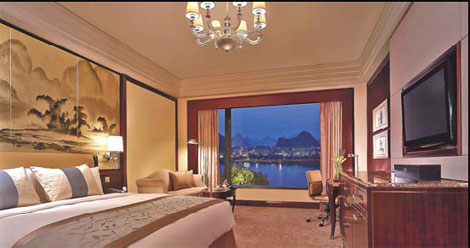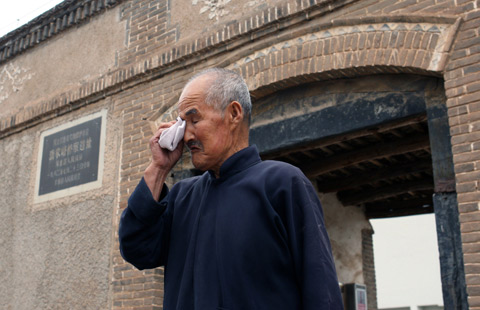Guilin's latest attraction towers over karst mountains
By Brad Webber (China Daily) Updated: 2010-06-15 07:28
|
Guestrooms of Shangri-La Hotel Guilin offer a stunning view of Lijiang River. Provided to China Daily |
The verdant and effortlessly splayed karst mountains of Guilin unfurled before me as I pulled open the hotel room draperies in a performance that was pure Panavision.
The hills, which have inspired legions of artists to recreate the rolling enchantment in paintings, prints and written paeans - not to mention the winsome backside of the 20-yuan note - are merely a backdrop for the Shangri-La Hotel, Guilin, a stunning new hotel that sets a new standard in the Guangxi Zhuang autonomous region.
If the gentle slopes were a salve, the Shangri-La was an oasis within an oasis after two hectic days of schlepping and low-impact spelunking amid the limestone: to the peak of Elephant Trunk Hill and into the phantasmagorical Reed Flute Caves.
Guilin's newest attraction - a hotel thoughtfully situated on a bend of the storied Lijiang River - puts on a show all its own. A dramatic lobby lounge, with its expansive windows, overlooks a terraced waterfall constructed to resemble the serpentine Longsheng rice paddies.
The Shangri-La balances sleek modernity with traditional elements. "It's not like a lot of Shangri-Las I know," says Sigi Bierbaumer, the hotel's general manager. "Most of the Shangri-Las are city properties, in towers. Ours takes up 68,000 square meters", a larger-than-usual footprint for a hotel in the Hong Kong-based chain.
Bierbaumer has served most of his career in the hospitality business in locales including Manila, Bangkok, Kuala Lumpur and Yangon. "Coming from Austria, it sounds very strange to people" that he has a particular affinity for hot climates.
In Guilin he gets his coveted lush surroundings, which are reflected, literally and figuratively, throughout the hotel. "Our hotel has a Chinese roof and a huge garden," Bierbaumer says.
Technically, that garden is in its nascent stage; the hotel opened in March, and during my visit in late May construction on the 449-room property was still under way. Still, I wouldn't have known it, thanks to the superb noise insulation in the serene guestrooms of 42 to 84 sq m, the largest in Guilin.
Rooms offer a riot of tasteful texture: Burgundy silk wallpaper contrasts nicely with the seating in various shades of mauve. Each guestroom is dominated by distinctive, handpainted murals featuring those stunning mountains. Rice paddies and Guilin's celebrated osmanthus blossoms play equal roles in the hotel's artistry.
The dining rooms offer delights that are delectable and olfactory, and the temptation is not lost on the local market, which flocks to the Li Caf buffet, thanks to its bountiful offerings and reasonable prices.
On a Saturday evening the place was boisterous, teeming with children. The din was a bit much, so I tried the buffet the following evening; loved the spicy Indian dishes conjured by sous chef Sunil Dutt.
I walked a few paces to U Bar, styled after a casual American pub with jukeboxes and pinball machines. My convivial server delivered the best filet mignon I've had in Asia. A lunch of delicious Cantonese dim sum at the Shang Palace showcased the diversity of foods.
The hotel strives for intimacy, but it's designed on a grand scale to help lure the coveted Meetings, Incentives, Conventions and Exhibitions market to Guangxi.
As Guilin boosts its infrastructure, conventioneers too will find the space they need with an 1,800-sq-m ballroom, the biggest in the region, and six smaller function rooms.
The Shangri-La was putting the final touches on an indoor pool, making the hotel the only one in town with pools indoor and out; two tennis courts and a room equipped with state-of-the-art exercise gear help round out the fitness offerings.
My regimen was limited to the great outdoors, however. I took the cruise to Yangshuo. It's the base for the Zhang Yimou-created Impression Liu Sanjie. Sadly, the outdoor light show with a cast of 600 had been canceled after heavy rains pelted the area.
The Shangri-La's human side wins as many points as the hardware. With 600 employees, including many members of the Yao, Zhuang and Dong ethnic groups, "We really tried to blend in the minority culture, right down to the fabric on the dresses," says Ruby Zhu, the hotel's communications manager.
Lost Horizon provided the inspiration for the luxe chain's name, (and taking a page from the Gideons, rooms are outfitted with a copy of James Hilton's 1933 novel), and it is said the motif is modeled after a Tibetan lamasery. If that be the case, the monks are living large. I might just convert.
China Daily
(China Daily 06/15/2010 page10)
- Mainland suspends cooking oil imports from Taiwan
- HK chief says reform must not abandon law
- HK stability vital for development: former governor of Macao
- Government urges economic fugitives to surrender
- Severe smog in north China to disperse
- What saddens Xi Jinping?
- 19 dead in Northwest China landslide
- China denounces US support for HK protest
- Four professors arrested for swindling scientific funds
- 25 arrested in alleged media scam








